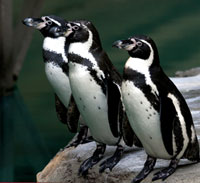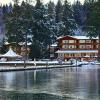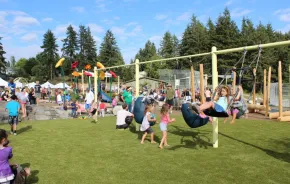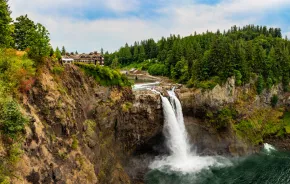Starting this May, as you near the western edge of the Woodland Park Zoo, you may wonder how it is that you’ve been suddenly and swiftly transported to the arid, rocky coast of Punta San Juan, Peru.
 So charming is the illusion, and so meticulously designed is the park’s naturalistic new Humboldt penguin habitat, that you’ll want to spend significantly more time with the black-and-white birds than you did in the past.
So charming is the illusion, and so meticulously designed is the park’s naturalistic new Humboldt penguin habitat, that you’ll want to spend significantly more time with the black-and-white birds than you did in the past.
The Humboldts’ new Seattle home — a huge improvement over the smaller, old-school exhibit that had been in place since 1947 — is well thought out and carefully constructed.
It was built not only as a sanctuary for the Humboldts, but to make visitors feel as if they’re interacting with penguins among the rocky tide pools and crashing waves of the Peruvian reserve, where nearly half of all Humboldt penguins nest.
“You’ll feel like you’re a visitor of the reserve rather than a zoo visitor,” says Monica Lake, the exhibit’s project manager.
Every detail of the new Humboldt penguin habitat has been attended to, from a realistic blowhole and a natural water filtration system to inconspicuously placed rock benches that allow parents to rest while their kids play.
The exhibit boasts several interactive “I’m a Penguin” areas, where children can climb, waddle and nest. Kids will also find a replica of a Peruvian fishing boat, a central hollow area that mimics a tide pool, and a short penguin scramble through low rocks near the habitat’s exit. “Kids engage their whole bodies in the penguin exhibit,” Lake says.
In addition, bubble windows and transparent walls are positioned at just the right height for small people to watch penguins swim underwater. Rebecca Whitham, spokesperson for the Woodland Park Zoo, says, “The underwater viewing will really show off these incredible animals at their best.”
Twenty penguins, brought in from the St. Louis Zoo and SeaWorld (among other animal sanctuaries), will initially populate the exhibit. And, with the assistance of specially positioned nesting boxes visible to the public, there’s room to grow as chicks hatch in coming years.
The new habitat aims not only to entertain and save energy with green features — an innovative filtration system, and geothermal heating and cooling — but to educate visitors about threats facing the endangered Humboldt. An interactive blind, such as one you’d find at Punta San Juan, re-creates a typical research setting, where you can watch work in progress as well as connect with Zoo Corps teen researchers. You’ll discover how, largely because of uncontrolled commercial fishing, the Humboldt population has dwindled to approximately 12,000 birds, and you’ll learn ways to help conserve the species.
Come experience Woodland Park Zoo’s most ambitious exhibit to date. And come ready to be enlightened, enriched and energized by a new habitat that is black and white and green all over.
Angie McCullagh lives in Seattle and blogs at ParentMap and Alladither.com.
GO
Opening day for the Humboldt exhibit is May 2, and activities — live South American music, zookeeper talks and giveaways — are free with admission ($11–$16.50, ages 2 and younger free). The exhibit is located near the west entrance, adjacent to the Rain Forest Pavilion. Starting May 1, the zoo is open daily, 9:30 a.m.–6 p.m. Visit the Woodland Park Zoo for the opening-day schedule.









